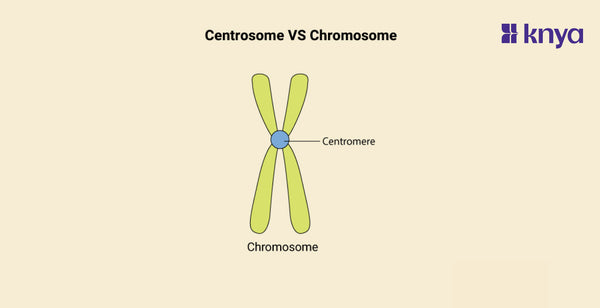Difference Between Centrosome and Chromosome: Centrosomes are non-membrane organelles that serve as the cell's microtubule organising centres (MTOCs). They function as small factories, producing microtubules, which are long, thin protein fibres that make up the cell's cytoskeleton and play an important role in cell division. During cell division, the centrosome doubles and migrates to opposing ends of the cell, generating the mitotic spindle poles. These microtubule fibres subsequently bind to chromosomes and tug them apart, ensuring that each daughter cell obtains the whole set of genetic material.
Centrosome
- They're microscopic structures near the nucleus, playing a key role in cell division.
- During cell division, they create microtubules, a network of fibers that guide chromosome separation.
- Precise chromosome distribution during division is vital for healthy cell growth and development.
- Composed of centrioles, which are tube-like structures, centrosomes help orchestrate the complex dance of cell division.
Chromosome
- They carry genetic information in the form of DNA, determining our traits and characteristics.
- Made up of DNA and proteins, they condense during cell division for proper separation.
- Humans have 23 pairs of chromosomes, one inherited from each parent.
- Proper chromosome number and structure are crucial for healthy development and functioning of our bodies.
Difference between Centrosome and Chromosome
Centrosomes and chromosomes are both essential players in cell division, but they have distinct roles.
|
Feature |
Centrosome |
Chromosome |
|
Definition |
Cellular organelle organizing microtubules |
Thread-like structure carrying genetic material |
|
Composition |
Two centrioles composed of microtubules |
DNA and proteins, including histones |
|
Function |
Organize and regulate mitotic spindle |
Carry genetic material, facilitate cell division |
|
Location |
Near the nucleus, close to centromere |
Within the nucleus |
|
Role in Cell Division |
Segregation of chromosomes |
Equal distribution of genetic material |
|
Number in a Cell |
Typically one |
Varies among species; humans have 46 (23 pairs) |
|
Dependency on Cell Cycle |
Replicates during cell cycle |
Undergoes replication and condensation |
|
Structural Dynamics |
Changes during different cell cycle stages |
Dynamic structure, condensation during cycle |
|
Associated Structures |
Microtubule-organizing proteins |
Genes, units of heredity |
|
Role in Cilia/Flagella |
Involved in formation |
Not directly involved |
Browse Best Scrubs Collection
What is Centrosome?
The centrosome is a tiny, non-membrane-bound organelle present in animal cells that aids in cell division. It serves as the cell's "microtubule organising centre," directing the creation of the mitotic spindle, a network of fibres that separates duplicated chromosomes during mitosis. Consider it the conductor of a complicated symphony, guiding the microtubule players to achieve the smooth and precise division of chromosomes into daughter cells.
Key Features of Centrosome:
- The centrosome is a cell's "microtubule organising centre" (MTOC). It has two barrel-shaped structures known as centrioles that serve as blueprints for the construction of microtubules, which are essential for cell division and other processes.
- During cell division, the centrosome doubles and moves to the opposing ends of the cell. These two "poles" then organise microtubules into a spindle, pulling replicated chromosomes apart to form daughter cells.
- While the centrosome is best recognised for cell division, it also participates in intracellular transport, cell migration, and, in some cells, the creation of cilia and flagella.
- Though centrosomes are common in animal cells, they may also be found in some algae and fungus, indicating their evolutionary relevance across various types of life.
What is Chromosome?
Chromosomes, on the other hand, are thread-like structures found within the nucleus that contain an organism's genetic information. They are composed of DNA and protein, which form densely packed bundles known as genes. Consider them the blueprints for creating and sustaining an organism, complete with instructions for inherited features and development. During cell division, chromosomes duplicate and are then properly separated by the microtubule spindle, ensuring that each daughter cell receives a full set of genetic instructions.
Key Features of Chromosomes:
- Chromosomes are thread-like structures that package and convey an organism's genetic material (DNA). They guarantee that genetic information is accurately transmitted during cell division.
- Each chromosome is made up of DNA wrapped tightly around protein spools known as histones. This organisation compacts a large quantity of DNA for efficient storage and transport.
- Prior to cell division, chromosomes repeat their DNA, resulting in identical sister chromatids linked at the centromere. This guarantees that each daughter cell receives the full set of genetic instructions.
- Each species has a distinct number of chromosomes. Humans have 23 pairs, each with a unique length, gene organisation, and staining pattern for identifying individual chromosomes.
Shop Best Lab Coats from Here!
Similarities between Centrosome and Chromosome
- Cellular Location: Both centrosomes and chromosomes are located within the eukaryotic cell.
- Role in Cell Division: Both centrosomes and chromosomes play critical roles in the process of cell division.
- Involvement in Replication: Both centrosomes and chromosomes undergo replication to ensure the accurate distribution of cellular components during cell division.
- Essential for Genetic Inheritance: Centrosomes and chromosomes are essential for the inheritance of genetic material from one generation of cells to the next.
- Dynamic Nature: Both centrosomes and chromosomes undergo dynamic structural changes during different phases of the cell cycle.
Although both centrosomes and chromosomes play important roles in cell division, they are separate structures. Chromosomes are thread-like structures in the nucleus that transport genetic material (DNA). They duplicate and segregate during cell division to ensure that genetic information is passed along correctly. Centrosomes, found near the nucleus, are non-membranous organelles that organise microtubules to create the mitotic spindle, which pushes duplicated chromosomes apart. While chromosomes provide the blueprint for life, centrosomes serve as the construction crew, guiding the exact sequence of cell division. Centrosomes are present in all eukaryotes, although they are lacking in plant cells, which use other methods for spindle production. In essence, chromosomes transmit genetic instructions, whereas centrosomes ensure their proper segregation during cell division.
| Check out More Articles | |
| Difference Between Cartilage and Bone | |
| Difference Between Endocrine and Exocrine Glands | |
| Difference Between Cell Wall and Cell Membrane | |















